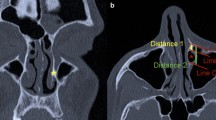Abstract
Gender and racial variations of the nasolacrimal system are important considerations to be aware of when planning for surgery or managing complications. This chapter seeks to synthesize the past and present literature describing bony anatomy and soft tissue variations. Regarding the nasolacrimal canal width and length, the majority of studies have shown a gender difference, with women in general having narrower canals than men. However, whether or not this difference actually plays a role in the higher prevalence of primary acquired nasolacrimal duct obstruction among women is not clear, as this association has not been found across all populations. Other important factors that play an important role in the development of nasolacrimal duct obstruction are inflammation, infection, and hormonal differences in men and women. In terms of length, there has not been a consistent difference when looking at race or gender, highlighting the need for a well-controlled comparison study. It has been observed that the frontal process of the maxilla appears to be thicker in Asians and Blacks, than in Whites, which should be accounted for in surgical planning. The chapter further expands upon the relationship of the lacrimal sac fossa to the ethmoidal sinus, as well as its relationship to the cribriform plate, which are both important considerations when performing a dacrocystorhinostomy. The soft tissue variations in race should also be accounted for when planning external dacryocystectomy incisions, such as nasal bridge width, the thickness of the skin, and the presence or absence of epicanthal folds.
Access this chapter
Tax calculation will be finalised at checkout
Purchases are for personal use only
Similar content being viewed by others
References
Groessl SA, Sires BS, Lemke BN. An anatomical basis for primary acquired nasolacrimal duct obstruction. Arch Ophthalmol. 1997;115(1):71–4.
Janssen AG, et al. Diameter of the bony lacrimal canal: normal values and values related to nasolacrimal duct obstruction—assessment with CT. Am J Neuroradiol. 2001;22(5):845–50.
Shigeta K, Takegoshi H, Kikuchi S. Sex and age differences in the bony nasolacrimal canal: an anatomical study. Arch Ophthalmol. 2007;125(12):1677–81.
Fasina O, Ogbole GI. CT assessment of the nasolacrimal canal in a black African population. Ophthal Plast Reconstr Surg. 2013;29(3):231–3.
McCormick A, Sloan B. The diameter of the nasolacrimal canal measured by computed tomography: gender and racial differences. Clin Experiment Ophthalmol. 2009;37(4):357–61.
Narioka J, Ohashi Y. Changes in lumen width of nasolacrimal drainage system after adrenergic and cholinergic stimulation. Am J Ophthalmol. 2006;141(4):689–98.
Ayub M, Thale AB, Hedderich J, Tillmann BN, Paulsen FP. The cavernous body of the human efferent tear ducts contributes to regulation of tear outflow. Invest Ophthalmol Vis Sci. 2003;44(11):4900–7.
Ramey NA, Hoang JK, Richard MJ. Multidetector CT of nasolacrimal canal morphology: normal variation by age, gender, and race. Ophthal Plast Reconstr Surg. 2013;29(6):475–80.
Ni C, et al. [The applied anatomy and measure of nasolacrimal duct]. Lin Chuang Er Bi Yan Hou Ke Za Zhi. 1999;13(2):62–3.
Groell R, et al. CT-anatomy of the nasolacrimal sac and duct. Surg Radiol Anat. 1997;19(3):189–91.
Woo KI, Maeng HS, Kim YD. Characteristics of intranasal structures for endonasal dacryocystorhinostomy in Asians. Am J Ophthalmol. 2011;152(3):491–8.
Hartikainen J, et al. Lacrimal bone thickness at the lacrimal sac fossa. Ophthalmic Surg Lasers. 1996;27(8):679–84.
Lui D. Ethnic ophthalmic plastic surgery. In: Bosniak S, editor. Principles and practice of ophthalmic plastic and reconstructive surgery, vol. II. Philadelphia: WB Saunders; 1996. p. 691–701.
Hinton P, Hurwitz JJ, Cruickshank B. Nasolacrimal bone changes in diseases of the lacrimal drainage system. Ophthalmic Surg. 1984;15(6):516–21.
Oestreicher JH, Chung HT, Hurwitz JJ. The correlation of clinical lacrimal bone density and thickness, established at the time of DCR surgery, with systemic bone mineral densitometry testing. Orbit. 2000;19(2): 73–9.
Looker AC, et al. Prevalence of low femoral bone density in older U.S. adults from NHANES III. J Bone Miner Res. 1997;12(11):1761–8.
Looker AC, et al. Prevalence of low femoral bone density in older U.S. women from NHANES III. J Bone Miner Res. 1995;10(5):796–802.
Zhang T, et al. [The clinical anatomy of lacrimal sac fossa]. Lin Chuang Er Bi Yan Hou Ke Za Zhi. 2003;17(11):652–3.
Talks SJ, Hopkisson B. The frequency of entry into an ethmoidal sinus when performing a dacryocystorhinostomy. Eye (Lond). 1996;10(Pt 6):742–3.
Botek AA, Goldberg SH. Margins of safety in dacryocystorhinostomy. Ophthalmic Surg. 1993;24(5):320–2.
Neuhaus RW, Baylis HI. Cerebrospinal fluid leakage after dacryocystorhinostomy. Ophthalmology. 1983;90(9):1091–5.
Kurihashi K, Yamashita A. Anatomical consideration for dacryocystorhinostomy. Ophthalmologica. 1991;203(1):1–7.
Author information
Authors and Affiliations
Corresponding author
Editor information
Editors and Affiliations
Rights and permissions
Copyright information
© 2015 Springer International Publishing Switzerland
About this chapter
Cite this chapter
Gausas, R.E., Abugo, U., Carter, S.R. (2015). Gender and Racial Variations of the Nasolacrimal System. In: Cohen, A., Mercandetti, M., Brazzo, B. (eds) The Lacrimal System. Springer, Cham. https://doi.org/10.1007/978-3-319-10332-7_3
Download citation
DOI: https://doi.org/10.1007/978-3-319-10332-7_3
Published:
Publisher Name: Springer, Cham
Print ISBN: 978-3-319-10331-0
Online ISBN: 978-3-319-10332-7
eBook Packages: MedicineMedicine (R0)




